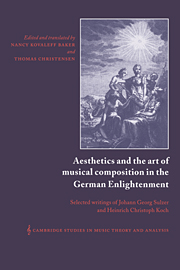 Aesthetics and the Art of Musical Composition in the German Enlightenment
Aesthetics and the Art of Musical Composition in the German Enlightenment Book contents
- Frontmatter
- Contents
- Foreword by Ian Bent
- PART I JOHANN GEORG SULZER GENERAL THEORY OF THE FINE ARTS (1771–74): SELECTED ARTICLES
- PART II HEINRICH CHRISTOPH KOCH INTRODUCTORY ESSAY ON COMPOSITION, VOL. II (1787)
- Introduction by Nancy Kovaleff Baker
- Preface
- Introduction
- I The aim and the inner nature of compositions and, above all, the way in which they arise
- Index
Preface
Published online by Cambridge University Press: 30 September 2009
- Frontmatter
- Contents
- Foreword by Ian Bent
- PART I JOHANN GEORG SULZER GENERAL THEORY OF THE FINE ARTS (1771–74): SELECTED ARTICLES
- PART II HEINRICH CHRISTOPH KOCH INTRODUCTORY ESSAY ON COMPOSITION, VOL. II (1787)
- Introduction by Nancy Kovaleff Baker
- Preface
- Introduction
- I The aim and the inner nature of compositions and, above all, the way in which they arise
- Index
Summary
I am indebted to the connoisseurs for the good reception and review of the first volume of this Introduction to Composition and for the encouragement to continue, {iv} and hereby discharge the debt. Partly for these readers and also partly to announce the reasons which led me to modify my outline slightly, a brief preface became necessary, which otherwise would have been superfluous.
According to the outline in the introduction to the first volume, this second volume was to begin and end with the {v} mechanical aspect of melody. Only in volume three, promised as an appendix, did I intend, among other things, to find an opportunity to apply a few general rules of the fine arts specifically to composition. Before the composer begins to invent melodies according to his training in the mechanical aspect of melody, I thought it necessary to pay more attention to the teaching of {vi} melody with a view to its usefulness for beginners and to make some observations on their often incorrect ideas about the way in which compositions arise in the mind of the composer. I wish first to instruct the beginning composer in the way that a composition must take shape in his mind if it is to attain the aim of art and to warn him of wrong and, for him, deleterious ways of proceeding in the invention of his future pieces of music.
- Type
- Chapter
- Information
- Aesthetics and the Art of Musical Composition in the German EnlightenmentSelected Writings of Johann Georg Sulzer and Heinrich Christoph Koch, pp. 137 - 139Publisher: Cambridge University PressPrint publication year: 1996
